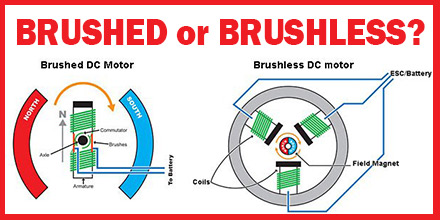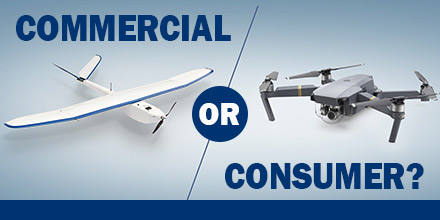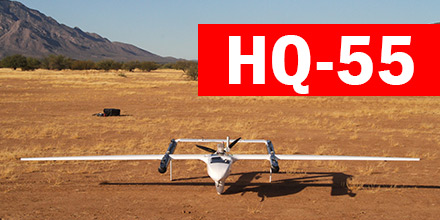
The biggest difference between brushed and brushless motors, unsurprisingly, is the brush. Otherwise, the principle behind the internal workings of brushed and brushless motors are much the same.
As the motor windings energize, it creates a temporary magnetic field to repel or attract permanent magnets. This magnetic force is converted to shaft rotation, allowing the motor to do work.
As the shaft rotates, the electric current is routed to different sets of windings. This maintains electromotive repulsion or attraction, forcing the rotor to continually rotate.
History of Brushed and Brushless Motors
The use of brushed DC motors began in 1856. Today, electrical propulsion, cranes, paper machines and steel rolling mills all use brushed motors.
One problem with brushed motors is that the brushes wear down and require frequent replacement. Brush wear became a significant drawback as application demands increased and high-electric discharge noise became an issue. Hence, a new motor was born...the brushless DC motor.
Brushless DC motors use electronic speed controller devices and quickly displaced brushed motors for many applications. Advancements in solid state technology in the early 1960s resulted in the invention of the first brushless DC (BLDC) motor in 1962. T.G. Wilson and P.H. Trickey called it a “DC machine with solid state commutation.” The key element of the brushless motor is that it requires no physical commutator, making it the most popular choice for computer disk drives, robotics, and aircrafts.
Brushless Motor Advantages
Brushless DC motors, with no brushes to wear out, represent a huge leap forward in technology. They also provide significantly higher efficiency and performance. They also offer a lower susceptibility to mechanical wear than their brushed counterparts.
Brushless motors offer several other advantages, including:
- Higher torque to weight ratio
- Increased torque per watt of power input (increased efficiency)
- Increased reliability and lower maintenance requirements
- Reduced operational and mechanical noise
- Longer lifespan (no brush and commutator erosion)
- Elimination of ionizing sparks from the commutator (ESD)
- Near-elimination of electromagnetic interference (EMI)
Today's Brushless Motors
Despite their reliability, the initial downside to early brushless motors was that they could not generate a great deal of power. When better permanent magnet materials became available in the 1980s, they enabled brushless motors to generate as much (or more) power as the previous brush motors on the market. In the late 80s, Robert E. Lordo built the first large-scale brushless DC motor with ten (10) times the power of the earlier brushless motors.
Today’s brushless motors solve many limitations of brushed motors by combining a higher output power, smaller size and weight, better heat dissipation and efficiency, wider operating speed ranges, and very low electrical noise operation. Brushless motors have no electrical contacts designed for wear, providing the greatest advantage in reliability and reduced maintenance intervals for commercial and industrial applications.
KDE Direct Brushless Motors
Designed and engineered in the United States, KDE Direct’s brushless motors provide best-in-class power, performance, and efficiency. From design redundancy standards and fail-safes to payload capacity and thrust performance, KDE Direct motors are engineered for longer flight times, higher efficiency and higher payloads that push the limits of today’s technology.
The KDE Direct UAS Multi-Rotor Brushless Motor Series presents high-quality and engineered motors specific for multi-rotor and UAS applications. The series was designed to provide market-leading performance and zero-vibration operation for hours of maintenance-free usage and market-leading performance.
Shop KDE Direct's complete Brushless Motor Series at Unmanned Systems Source.
 Is there a difference in the accuracy of survey data from a consumer “retail” system versus a commercial system? If so, what is that difference?
Over the Summer, the team at Altavian -- manufacturer of the Nova F7200 -- decided to find out.
Is there a difference in the accuracy of survey data from a consumer “retail” system versus a commercial system? If so, what is that difference?
Over the Summer, the team at Altavian -- manufacturer of the Nova F7200 -- decided to find out.

 Recently, Aeromao Inc., delivered an Aeromapper 300 to the University of Brasilia in Brazil. The customized UAV arrived ready to integrate the Nano-Hyperspectral camera from Headwell Photonics.
After initial approval, the team completed the custom integration in just a few weeks.
Recently, Aeromao Inc., delivered an Aeromapper 300 to the University of Brasilia in Brazil. The customized UAV arrived ready to integrate the Nano-Hyperspectral camera from Headwell Photonics.
After initial approval, the team completed the custom integration in just a few weeks.
 The HQ-55, the newest airframe from
The HQ-55, the newest airframe from  An Ingress Protection Rating, or IP rating, is a laboratory-certified industrial rating for a piece of electronic equipment or an enclosure for electrical equipment.
The IP Rating explains the degree of protection provided against debris and water intrusion. It also measures protection against accidental contact -- including body parts like fingers or hands -- to critical components.
Developed by the International Electrotechnical Commission (IEC), this internationally recognized rating system is in wide use in Europe and Asia. North America is adopting this standard at a slower pace.
An Ingress Protection Rating, or IP rating, is a laboratory-certified industrial rating for a piece of electronic equipment or an enclosure for electrical equipment.
The IP Rating explains the degree of protection provided against debris and water intrusion. It also measures protection against accidental contact -- including body parts like fingers or hands -- to critical components.
Developed by the International Electrotechnical Commission (IEC), this internationally recognized rating system is in wide use in Europe and Asia. North America is adopting this standard at a slower pace.
 SPH Engineering announces the launch of UgCS centralized drone management solution for Police, Search and Rescue, Firefighter and Security Service Command centers for efficient drone implementation in first response and surveillance operations.
This centralized solution was presented at MiliPol 2017.
SPH Engineering announces the launch of UgCS centralized drone management solution for Police, Search and Rescue, Firefighter and Security Service Command centers for efficient drone implementation in first response and surveillance operations.
This centralized solution was presented at MiliPol 2017.
 The biggest difference between brushed and brushless motors, unsurprisingly, is the brush. Otherwise, the principle behind the internal workings of brushed and brushless motors are much the same.
As the motor windings energize, it creates a temporary magnetic field to repel or attract permanent magnets. This magnetic force is converted to shaft rotation, allowing the motor to do work.
As the shaft rotates, the electric current is routed to different sets of windings. This maintains electromotive repulsion or attraction, forcing the rotor to continually rotate.
The biggest difference between brushed and brushless motors, unsurprisingly, is the brush. Otherwise, the principle behind the internal workings of brushed and brushless motors are much the same.
As the motor windings energize, it creates a temporary magnetic field to repel or attract permanent magnets. This magnetic force is converted to shaft rotation, allowing the motor to do work.
As the shaft rotates, the electric current is routed to different sets of windings. This maintains electromotive repulsion or attraction, forcing the rotor to continually rotate.
